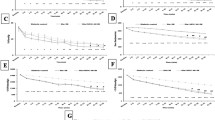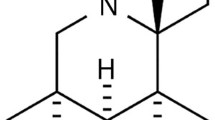Abstract
The objective of the current study is to investigate whether ginsenoside Rb1, a major pharmacological extract of ginseng that could attenuate myocardial ischemia reperfusion (MI/R) injury in non-diabetic myocardium, can attenuate MI/R injury in diabetes that are more vulnerable to ischemic insult. Rats were divided into seven groups: (i) diabetic sham, (ii) diabetic, (iii) normal, (iv) diabetic + ginsenoside Rb1, (v) diabetic + wortmannin, (vi) diabetic + wortmannin + ginsenoside Rb1, (vii) diabetic sham + wortmannin. Ginsenoside Rb1 and/or wortmannin were administered prior to inducing MI/R (30 min of coronary artery occlusion followed by 120 min reperfusion). At the end of the experiment, postischemic myocardial infarct size was significantly higher in the diabetic untreated group as compared to normal (P < 0.05), accompanied with increased myocardial apoptosis, elevated plasma CK-MB and LDH release and reduced blood pressure. Ginsenoside Rb1 reduced infarct size, cardiomyocyte apoptosis and caspase-3 activity compared to the diabetic group. The cardioprotective effects of ginsenoside Rb1 were cancelled by wortmannin. Ginsenoside Rb1 significantly upregulated phosphorylated Akt expression, which was attenuated by wortmannin. Ginsenoside Rb1 exerts cardioprotective effects against MI/R injury in diabetic rats, which is partly through activation of phosphatidylinositol 3-kinase (PI3 K)/Akt pathway. Thus this study shows a novel pharmacological preconditioning with ginsenoside Rb1 in the diabetic myocardium.







Similar content being viewed by others
References
Trichon BH, Roe MT (2004) Acute coronary syndromes and diabetes mellitus. Diab Vasc Dis Res 1:23–32
Paulson DJ (1997) The diabetic heart is more sensitive to ischemic injury. Cardiovasc Res 34:104–112
Donahoe SM, Stewart GC, McCabe CH, Mohanavelu S, Murphy SA, Cannon CP, Antman EM (2007) Diabetes and mortality following acute coronary syndromes. JAMA 298:765–775
Wild S, Roglic G, Green A, Sicree R, King H (2004) Global prevalence of diabetes: estimates for the year 2000 and projections for 2030. Diabetes Care 27:1047–1053
Zdychova J, Komers R (2005) Emerging role of Akt kinase/protein kinase B signaling in pathophysiology of diabetes and its complications. Physiol Res 54:1–16
Gross ER, Hsu AK, Gross GJ (2007) Diabetes abolishes morphine-induced cardioprotection via multiple pathways upstream of glycogen synthase kinase-3beta. Diabetes 56:127–136
Tanaka K, Kehl F, Gu W, Krolikowski JG, Pagel PS, Warltier DC, Kersten JR (2002) Isoflurane-induced preconditioning is attenuated by diabetes. Am J Physiol Heart Circ Physiol 282:H2018–H2023
Sengupta S, Toh SA, Sellers LA, Skepper JN, Koolwijk P, Leung HW, Yeung HW, Wong RN, Sasisekharan R, Fan TP (2004) Modulating angiogenesis: the yin and the yang in ginseng. Circulation 110:1219–1225
Yu J, Eto M, Akishita M, Kaneko A, Ouchi Y, Okabe T (2007) Signaling pathway of nitric oxide production induced by ginsenoside Rb1 in human aortic endothelial cells: a possible involvement of androgen receptor. Biochem Biophys Res Commun 353:764–769
Wang YL, Wang CY, Zhang BJ, Zhang ZZ (2009) Shenfu injection suppresses apoptosis by regulation of Bcl-2 and caspase-3 during hypoxia/reoxygenation in neonatal rat cardiomyocytes in vitro. Mol Biol Rep 36:365–370
Xia ZY, Liu XY, Zhan LY, He YH, Luo T, Xia Z (2005) Ginsenosides compound (shen-fu) attenuates gastrointestinal injury and inhibits inflammatory response after cardiopulmonary bypass in patients with congenital heart disease. J Thorac Cardiovasc Surg 130:258–264
Zhu S, Zou K, Fushimi H, Cai S, Komatsu K (2004) Comparative study on triterpene saponins of Ginseng drugs. Planta Med 70:666–677
Leung KW, Cheung LW, Pon YL, Wong RN, Mak NK, Fan TP, Au SC, Tombran-Tink J, Wong AS (2007) Ginsenoside Rb1 inhibits tube-like structure formation of endothelial cells by regulating pigment epithelium-derived factor through the oestrogen beta receptor. Br J Pharmacol 152:207–215
Zhang QH, Wu CF, Duan L, Yang JY (2008) Protective effects of total saponins from stem and leaf of Panax ginseng against cyclophosphamide-induced genotoxicity and apoptosis in mouse bone marrow cells and peripheral lymphocyte cells. Food Chem Toxicol 46:293–302
Shang W, Yang Y, Zhou L, Jiang B, Jin H, Chen M (2008) Ginsenoside Rb1 stimulates glucose uptake through insulin-like signaling pathway in 3T3–L1 adipocytes. J Endocrinol 198:561–569
Zhao H, Lv D, Zhang W, Dong W, Feng J, Xiang Z, Huang L, Qin C, Zhang L (2010) Ginsenoside-Rb1 attenuates dilated cardiomyopathy in cTnT(R141 W) transgenic mouse. J Pharmacol Sci 112:214–222
Wang Z, Li M, Wu WK, Tan HM, Geng DF (2008) Ginsenoside Rb1 preconditioning protects against myocardial infarction after regional ischemia and reperfusion by activation of phosphatidylinositol-3-kinase signal transduction. Cardiovasc Drugs Ther 22:443–452
Xia Z, Kuo KH, Nagareddy PR, Wang F, Guo Z, Guo T, Jiang J, McNeill JH (2007) N-acetylcysteine attenuates PKCbeta2 overexpression and myocardial hypertrophy in streptozotocin-induced diabetic rats. Cardiovasc Res 73:770–782
Shinohara T, Takahashi N, Ooie T, Hara M, Shigematsu S, Nakagawa M, Yonemochi H, Saikawa T, Yoshimatsu H (2006) Phosphatidylinositol 3-kinase-dependent activation of akt, an essential signal for hyperthermia-induced heat-shock protein 72, is attenuated in streptozotocin-induced diabetic heart. Diabetes 55:1307–1315
Wang J, Qiao L, Li Y, Yang G (2008) Ginsenoside Rb1 attenuates intestinal ischemia-reperfusion-induced liver injury by inhibiting NF-kappaB activation. Exp Mol Med 40:686–698
Yang J, Yang J, Ding JW, Chen LH, Wang YL, Li S, Wu H (2008) Sequential expression of TLR4 and its effects on the myocardium of rats with myocardial ischemia-reperfusion injury. Inflammation 31:304–312
Hotta H, Miura T, Miki T, Togashi N, Maeda T, Kim SJ, Tanno M, Yano T, Kuno A, Itoh T, Satoh T, Terashima Y, Ishikawa S, Shimamoto K (2010) Angiotensin II type 1 receptor-mediated upregulation of calcineurin activity underlies impairment of cardioprotective signaling in diabetic hearts. Circ Res 106:129–132
Tsang A, Hausenloy DJ, Mocanu MM, Carr RD, Yellon DM (2005) Preconditioning the diabetic heart: the importance of Akt phosphorylation. Diabetes 54:2360–2364
Hausenloy DJ, Yellon DM (2006) Survival kinases in ischemic preconditioning and postconditioning. Cardiovasc Res 70:240–253
Penumathsa SV, Thirunavukkarasu M, Samuel SM, Zhan L, Maulik G, Bagchi M, Bagchi D, Maulik N (2009) Niacin bound chromium treatment induces myocardial Glut-4 translocation and caveolar interaction via Akt, AMPK and eNOS phosphorylation in streptozotocin induced diabetic rats after ischemia-reperfusion injury. Biochim Biophys Acta 1792:39–48
Zhou W, Chai H, Lin PH, Lumsden AB, Yao Q, Chen C (2005) Ginsenoside Rb1 blocks homocysteine-induced endothelial dysfunction in porcine coronary arteries. J Vasc Surg 41:861–868
Lin J, Steenbergen C, Murphy E, Sun J (2009) Estrogen receptor-beta activation results in S-nitrosylation of proteins involved in cardioprotection. Circulation 120:245–254
Hisamoto K, Ohmichi M, Kurachi H, Hayakawa J, Kanda Y, Nishio Y, Adachi K, Tasaka K, Miyoshi E, Fujiwara N, Taniguchi N, Murata Y (2001) Estrogen induces the Akt-dependent activation of endothelial nitric-oxide synthase in vascular endothelial cells. J Biol Chem 276:3459–3467
Simoncini T, Hafezi-Moghadam A, Brazil DP, Ley K, Chin WW, Liao JK (2000) Interaction of oestrogen receptor with the regulatory subunit of phosphatidylinositol-3-OH kinase. Nature 407:538–541
Hwang YP, Jeong HG (2010) Ginsenoside Rb1 protects against 6-hydroxydopamine-induced oxidative stress by increasing heme oxygenase-1 expression through an estrogen receptor-related PI3 K/Akt/Nrf2-dependent pathway in human dopaminergic cells. Toxicol Appl Pharmacol 242:18–28
Gao F, Gao E, Yue TL, Ohlstein EH, Lopez BL, Christopher TA, Ma XL (2002) Nitric oxide mediates the antiapoptotic effect of insulin in myocardial ischemia-reperfusion: the roles of PI3-kinase, Akt, and endothelial nitric oxide synthase phosphorylation. Circulation 105:1497–1502
Hausenloy DJ, Yellon DM (2004) New directions for protecting the heart against ischaemia-reperfusion injury: targeting the reperfusion injury salvage kinase (RISK)-pathway. Cardiovasc Res 61:448–460
Cross TG, Scheel-Toellner D, Henriquez NV, Deacon E, Salmon M, Lord JM (2000) Serine/threonine protein kinases and apoptosis. Exp Cell Res 256:34–41
Scott GI, Colligan PB, Ren BH, Ren J (2001) Ginsenosides Rb1 and Re decrease cardiac contraction in adult rat ventricular myocytes: role of nitric oxide. Br J Pharmacol 134:1159–1165
Schulz R, Kelm M, Heusch G (2004) Nitric oxide in myocardial ischemia/reperfusion injury. Cardiovasc Res 61:402–413
Brunner F, Maier R, Andrew P, Wolkart G, Zechner R, Mayer B (2003) Attenuation of myocardial ischemia/reperfusion injury in mice with myocyte-specific overexpression of endothelial nitric oxide synthase. Cardiovasc Res 57:55–62
Acknowledgments
This work was supported by the National Natural Science Foundation of China (No.30672033).
Author information
Authors and Affiliations
Corresponding author
Rights and permissions
About this article
Cite this article
Wu, Y., Xia, Zy., Dou, J. et al. Protective effect of ginsenoside Rb1 against myocardial ischemia/reperfusion injury in streptozotocin-induced diabetic rats. Mol Biol Rep 38, 4327–4335 (2011). https://doi.org/10.1007/s11033-010-0558-4
Received:
Accepted:
Published:
Issue Date:
DOI: https://doi.org/10.1007/s11033-010-0558-4




